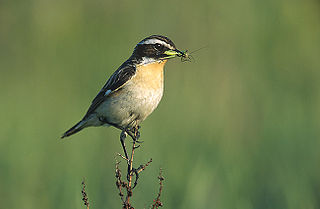
Chats are a group of small Old World insectivorous birds formerly classified as members of the thrush family (Turdidae), but following genetic DNA analysis, are now considered to belong to the Old World flycatcher family (Muscicapidae).

Libinia emarginata, the portly spider crab, common spider crab or nine-spined spider crab, is a species of stenohaline crab that lives on the Atlantic coast of North America.
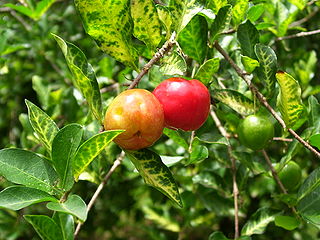
Malpighia is a genus of flowering plants in the nance family, Malpighiaceae. It contains about 45 species of shrubs or small trees, all of which are native to the American tropics. The generic name honours Marcello Malpighi, a 17th-century Italian physician and botanist. The species grow to 1–6 m (3.3–19.7 ft) tall, with a dense, often thorny crown. The leaves are evergreen, simple, 0.5–15 cm (0.20–5.91 in) long, with an entire or serrated margin. The flowers are solitary or in umbels of two to several together, each flower 1–2 cm (0.39–0.79 in) diameter, with five white, pink, red, or purple petals. The fruit is a red, orange, or purple drupe, containing two or three hard seeds. M. emarginata is cultivated for its sweet and juicy fruits, which are very rich in vitamin C.

Ceratonia is small genus of flowering trees in the pea family, Fabaceae, endemic to the Mediterranean region and the Middle East. Its best known member, the carob tree, is cultivated for its pods and has been widely introduced to regions with similar climates. The genus was long considered monotypic, but a second species, Ceratonia oreothauma, was identified in 1979 from Oman and Somalia. It is in the tribe Umtizieae, subfamily Caesalpinioideae.

Prunus emarginata, the bitter cherry or Oregon cherry, is a species of Prunus native to western North America, from British Columbia south to Baja California, and east as far as western Wyoming and New Mexico. It is often found in recently disturbed areas or open woods on nutrient-rich soil.
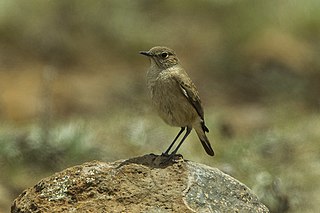
The sickle-winged chat or sicklewing chat is a small passerine bird of the Old World flycatcher family Muscicapidae endemic to southern Africa. It is a common resident breeder in South Africa and Lesotho, and is also found in southernmost areas of Botswana and Namibia. Its habitat is Karoo scrub, short grassland, and barren sandy or stony areas. In western coastal areas, it also occurs on agricultural land.

Noronhia emarginata is a species of Noronhia native to Madagascar, now naturalized on Mauritius, Réunion and Bermuda.

Idaea emarginata, the small scallop, is a moth of the family Geometridae. It was first described by Carl Linnaeus in his 1758 10th edition of Systema Naturae and it is found in Europe.
Microsynodontis emarginata is a species of upside-down catfish endemic to Gabon where it occurs in the Ogowe River. It was first described in 2004 by Ng Heok Hee.

Acriopsis emarginata, commonly known as the pale chandelier orchid, is a species of orchid endemic to Queensland. It is a clump-forming epiphyte with dark green leaves and curved, branching flower stems with many white and cream-coloured flowers.
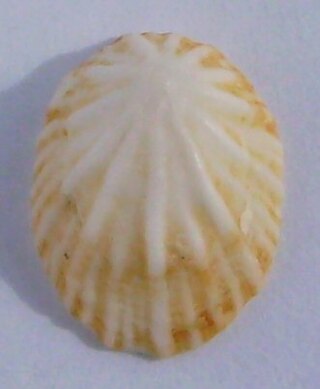
Hemitoma is a genus of slit limpets, marine gastropod molluscs in the family Fissurellidae, the keyhole limpets and slit limpets.
P. emarginata may refer to:
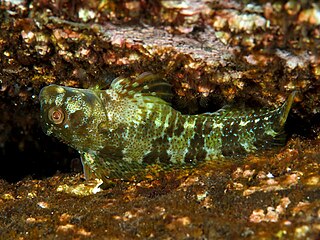
Scartella emarginata is a species of combtooth blenny found in the Indian ocean. This species reaches a length of 10 centimetres (3.9 in) SL.

Oraesia emarginata is a species of moth of the family Erebidae first described by Johan Christian Fabricius in 1794. It is found in Australia, New Caledonia, Indonesia, New Guinea, Pakistan, the Philippines, India, Sri Lanka, Sulawesi, Taiwan, China, Japan, Korea and Nepal as well as Eritrea, Ethiopia, Kenya, Namibia, Nigeria, South Africa, Tanzania, the Gambia, Uganda, Oman and Yemen.

Emarginata is a genus of birds in the Old World flycatcher family Muscicapidae that occur in southern Africa.
Obolopteryx emarginata, the spoon-tail short-wing katydid, is the type species of phaneropterine katydids of its genus and in the family Tettigoniidae. It is found in North America.
Prunus × pugetensis is a hybrid species of cherry discovered growing in the Pacific Northwest region of North America. It has been given the nominal common name Puget Sound cherry. It is a cross of introduced sweet cherry, Prunus avium, and native Oregon cherry, Prunus emarginata. Individuals have been found growing in British Columbia, Washington state and Oregon, in the natural range of P. emarginata. It differs from P. avium in a number of features, including having narrower leaves and smaller flowers carried on a peduncle. Conversely, it has broader leaves and larger flowers than P. emarginata. The chief difference from its parents is that its flowers almost always abort, and it rarely bears any fruit.

Northpark Copse to Snapelands Copse is a 101.4-hectare (251-acre) biological Site of Special Scientific Interest north of Midhurst in West Sussex.

Obolopteryx is a North American genus of katydids or bush crickets in the subfamily Phaneropterinae and tribe Odonturini.















